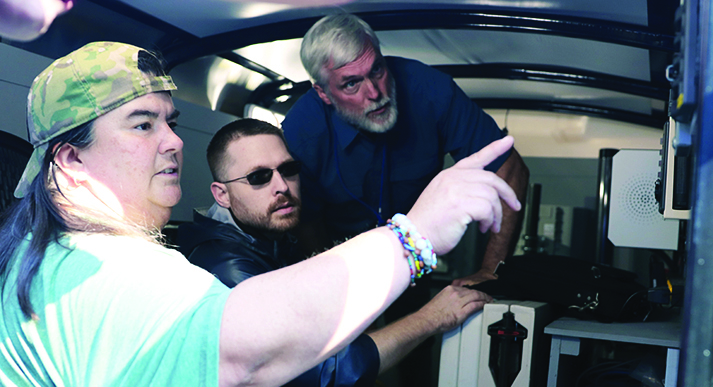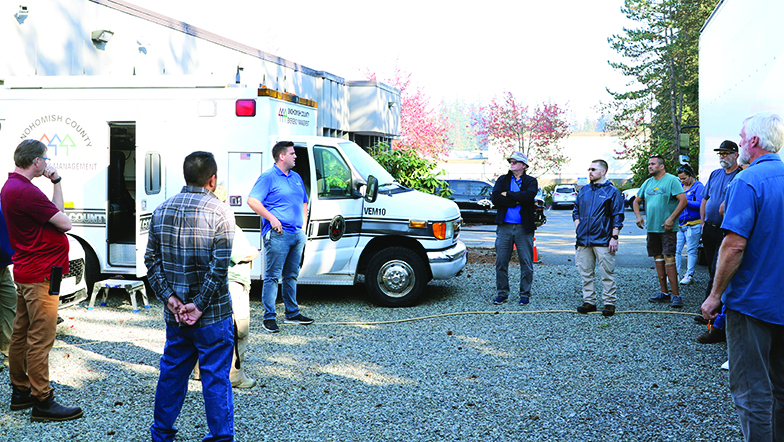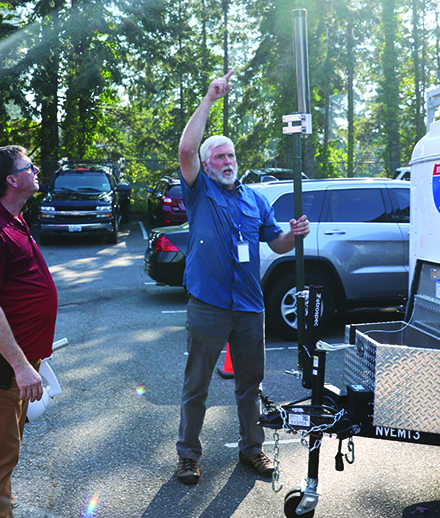
By Kalvin Valdillez, Tulalip News
A group of twenty people circled up outside of the Snohomish County Department of Emergency Management (DEM) on the afternoon of October 13. Cars, semis, and motorcycles zoomed down Washington State Route 526 and airplanes flew by overhead as the group exchanged introductions and pleasantries at the DEM, which is located at the Paine Field area of Everett. With notebooks and writing utensils in-hand, the group was comprised of several representatives of Tulalip departments who showed up ready and eager to learn about the DEM and tour its facility. Collectively, this group is officially known as the Tulalip Emergency Response Team.
“The team; we have our public works department, our utilities department, community health department, Fire department, Police department, GIS, and TDS,” explained Emergency Preparedness Coordinator, Angel Cortez. “We’re going to need more departments to assist because when something happens, there is a whole army that’s needed – boots on the ground workforce to make sure that everybody is able to respond, that we’re connecting to who we need to connect with to get resources. To get all these different departments involved is important.”
Since stepping into the position of Emergency Preparedness Coordinator, Angel has been on a mission to ensure his community is best prepared for any situation if a disaster were to strike the sduhubš homelands. Upon visiting the DEM for the first time, he found inspiration to create a similar setting on the reservation that can be readily available to assist the Tulalip people in the event of a crisis or natural disaster. Angel organized the tour of the DEM for the tribal emergency response team to give them a glimpse of the vision he has in mind for Tulalip.
Leading the tour was the Snohomish County Emergency Management Program Manager, Jarrod Dibble, who gave a detailed account of what the DEM is, how they service local communities, as well as a few examples of how they handled emergency situations in the past such as the Oso landslide and more recently, the Bolt Creek wildfire.
“We started outside today with our deployable assets,” said Jarrod while recapping the tour. “We have a couple small trailers that are solar powered that provide network capability and Wi-Fi calling – redundant capability with internet for those kinds of standalone deployable trailers. And then we looked at a couple of our other deployable vehicles that are command and control centers. One is a vehicle that can actually drive to our trailers, but act as a mobile emergency operation center (EOC). And inside is our actual EOC, where we talked about the upgrades we’ve done over the years, the lessons learned about what works well, what doesn’t work well, how we coordinate, and the room being set up to follow the instant command system structures that are standard for emergency management.”

The two-hour tour was intriguing, to say the least, for the Tulalip Emergency Response Team While viewing the high-tech trailers filled with monitor screens, cables, and CB radios, the members of the Emergency Response Team shared excited glances with one another, no doubt already exchanging telepathic ideas about how to design deployable trailers for the community of Tulalip.
The highlight for many was the in-person viewing of the DEM’s EOC. Multiple computer stations are set up in a large room of the facility, which accounts for nearly half of the entire DEM. The workstations are sectioned off by departments and agencies such as public safety, planning, resourcing, and GIS. According to FEMA, “An EOC is a central command and control system responsible for carrying out the principles of emergency preparedness and emergency management, or disaster management at a strategic level during an emergency, and ensuring the continuity of operation of a company, political subdivision, or other organization. The primary function of staff in EOC’s include collecting, analyzing and sharing information, supporting resource needs and requests, including allocation and tracking, coordinating plans and determining current and future needs. And in some cases, providing coordination and policy direction.”
Jarrod explained that the Snohomish County Emergency Management and the Tulalip Tribes have an inter-local agreement (ILA) which outlines everything that the County can provide for the tribe such as planning and training, as well as the ability to respond to a disaster on Tulalip’s behalf. The Snohomish County DEM will be offering said trainings in the near future to the Tulalip Emergency Response Team and in-turn, Angel hopes to offer those trainings to the community down the line.

After re-establishing monthly meetings for the tribe’s emergency response team after the pandemic, Angel now hopes to build a permanent EOC at Tulalip that could be utilized during windstorms, power outages, water shortages, and during a number of incidents that require additional resources and/or medical attention. With an established EOC, the Tulalip Emergency Response Team will also have the ability to hire on volunteers and provide the necessary trainings in order for them to assist in the event of an emergency. And by training volunteers, Angel believes that this could ultimately lead to a career path for many, or at the very least beef up a few resumes.
Angel said, “I want Tulalip to be an asset, not a responsibility or liability. To be able to manage an incident without having to rely on the outside partners, I think is going to be huge for our community. But it is also going to take time and a lot of effort and planning. I would like to see Tulalip take the steps towards having our own emergency operating center, so that when a situation does happen, we’re ready to go. The ILA that we have with the county, it’s very good that we have that. But I don’t want to solely rely on that, because if it’s a big disaster, they’re not just going to come and assist Tulalip with everything, they’re going to be spread out throughout the whole county. We need to be able to handle incidents on our own, to the best of our ability.”
The Tulalip Emergency Response Team left the DEM filled with optimism, and many of its members now share Angel’s vision of bringing an EOC to Tulalip. The tour was just the first step down a long road. But after experiencing the local DEM in-person, the response team is all the more committed to ensuring the safety of the Tulalip citizenship through disaster preparedness and emergency management.